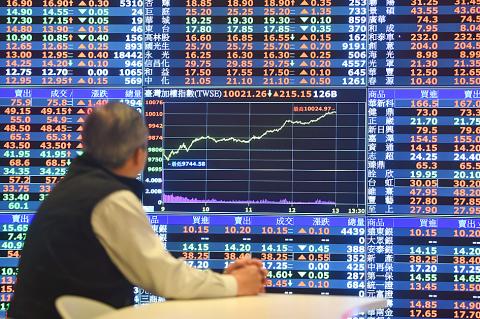The TAIEX rebounded yesterday, gaining 2.44 percent to close at 10,045.81 points after slumping 6.3 percent on Thursday, its worst one-day slide since January 2008.
The weighted index opened 5.47 points higher at 9,811.58 points, but retreated to 9,742.34 points after seven minutes of trading, lower than its close of 9,806.11 on Thursday.
However, it gradually gained ground as sentiment improved, moving past 10,000 points and closing 239.7 points higher on turnover of NT$143.53 billion (US$4.64 billion), Taiwan Stock Exchange (TWSE) data showed.

Photo: Liao Chen-huei, Taipei Times
Except for glass and electric appliances, all sub-indices advanced, the data showed.
The rebound was led by smartphone camera lens maker Largan Precision Co (大立光), which erased Wednesday’s losses by advancing 9.89 percent to NT$3,555, and Taiwan Semiconductor Manufacturing Co (台積電, TSMC), the world’s largest contract chipmaker, which closed 4.18 percent higher at NT$231.
The local market rose as the across-the-board selloffs ended in Asia, with South Korea and Hong Kong gaining 1.5 percent and 2.1 percent respectively, while Japan’s Nikkei 225 rose 0.5 percent and Shanghai climbed 0.9 percent, even though US markets continued their steep declines on Thursday, with the Dow Jones Industrial Average falling 545 points after plunging 831 points on Wednesday.
However, the scale of the decline in the Dow shrank, Xincheng International Investment Consultant (信誠環球投顧) analyst Chang Chih-cheng (張志誠) said.
Citing the fall in the yield on benchmark 10-year US Treasuries to 3.14 percent, Chang said that global investor anxiety seemed to have eased after official figures showed that US consumer prices for last month rose at a slower-than-expected pace.
However, judging from the fact that foreign institutional investors still sold a net NT$4.09 billion in local shares, the market’s recovery likely stemmed in part from bargain-hunting by government-run funds to lend support to the market, Chang said.
Although the government on Thursday evening decided not to activate the National Stabilization Fund for the time being, its announcement that the fund committee would hold a special meeting whenever necessary to deal with changes in the market helped lift sentiment, Hua Nan Securities Investment Management Co (華南投顧) chairman David Chu (儲祥生) said.
“However, it is hard to say that Taiwanese shares have regained a firm foothold,” Chu said.
Investors should keep a close watch on the performance of US markets and TSMC’s investors’ conference on Thursday next week to gain an insight into the nation’s economic outlook in the fourth quarter, he said.

UNCERTAINTY: Investors remain worried that trade negotiations with Washington could go poorly, given Trump’s inconsistency on tariffs in his second term, experts said The consumer confidence index this month fell for a ninth consecutive month to its lowest level in 13 months, as global trade uncertainties and tariff risks cloud Taiwan’s economic outlook, a survey released yesterday by National Central University found. The biggest decline came from the timing for stock investments, which plunged 11.82 points to 26.82, underscoring bleak investor confidence, it said. “Although the TAIEX reclaimed the 21,000-point mark after the US and China agreed to bury the hatchet for 90 days, investors remain worried that the situation would turn sour later,” said Dachrahn Wu (吳大任), director of the university’s Research Center for

Alchip Technologies Ltd (世芯), an application-specific integrated circuit (ASIC) designer specializing in artificial-intelligence (AI) chips, yesterday said that small-volume production of 3-nanometer (nm) chips for a key customer is on track to start by the end of this year, dismissing speculation about delays in producing advanced chips. As Alchip is transitioning from 7-nanometer and 5-nanometer process technology to 3 nanometers, investors and shareholders have been closely monitoring whether the company is navigating through such transition smoothly. “We are proceeding well in [building] this generation [of chips]. It appears to me that no revision will be required. We have achieved success in designing

PROJECTION: KGI Financial said that based on its foreign exchange exposure, a NT$0.1 increase in the New Taiwan dollar would negatively impact it by about NT$1.7 billion KGI Financial Holding Co (凱基金控) yesterday said its life insurance arm has increased hedging and adopted other moves to curb the impact of the local currency’s appreciation on its profitability. “It is difficult to accurately depict the hedging costs, which might vary from 7 percent to 40 percent in a single day,” KGI Life Insurance Co (凱基人壽) told an investors’ conference in Taipei. KGI Life, which underpinned 66 percent of the group’s total net income last year, has elevated hedging to 55 to 60 percent, while using a basket of currencies to manage currency volatility, the insurer said. As different

Taiwanese insurers are facing difficult questions about the damage of recent swings in the New Taiwan dollar. Regulators might have a partial solution: letting firms change how they calculate the value of foreign currency assets. The Financial Supervisory Commission (FSC) is considering allowing insurers to use six-month average exchange rates when they calculate risk-based capital in their semiannual reports, a shift from the current system where insurers use exchange rates on the final day of reporting. The change could ease pressure on the US$1.2 trillion insurance sector, whose huge exposure to foreign assets came into the spotlight earlier this month after a